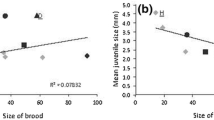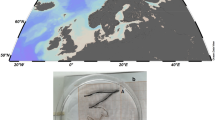Abstract
The organic matter content in the eggs and early larvae of the ctenophores Mnemiopsis leidyi and Beroe ovata from the Black Sea was determined using the adapted microtechnique of dichromate oxidation. The content of organic matter in the eggs of M. leidyi (0.25 μg/indiv.) was 5 times less than in B. ovata (1.28 ± 0.29 μg/indiv.). The somatic content of organic matter was 0.25 ± 0.09 μg/indiv. (25.1 ± 8.3 μg/mg, wet wt) for 2-day-old larvae of M. leidyi (0.2–0.3 mm in body length) and 1.37 ± 0.19 μg/indiv. (67.1 ± 5.7 μg/mg wet wt) for larvae of B. ovata (0.4 mm in body length). The specific organic content of larvae of both species steadily decreased with an increase in ctenophore body size and weight, approaching 3–4 μg/mg of wet weight for 2 mm specimens of M. leidyi and 3–5 μg/mg of wet weight for 6 mm B. ovata. The specific organic content of early larvae was 20–30 times higher than that of adult ctenophores. The results of this investigation could be useful in the evaluation of the energy budget for somatic growth and generative production in these species. Calculations indicate that with specific wet weight growth rates of 0.43/day for M. leidyi larvae and 0.29/day for B. ovata larvae, their true organic increases are respectively 30 and 38% less, i.e., no more than 0.31/day for the former and 0.18/day for the latter species.
Similar content being viewed by others
References
Anninsky, B.E. and Gubanova, A.D., Chemical Composition and Condition of the Ctenophore Mnemiopsis mccradyi (Mayer) in the Black Sea, Gidrobiol. Zh., 1998, vol. 34, no. 3, pp. 36–43.
Anninsky, B.E. and Abolmasova, G.I., Temperature as a Factor of the Level of Metabolism and Mass Development of the Ctenophore Mnemiopsis leidyi in the Black Sea, Okeanologiya, 2000, vol. 40, no. 5, pp. 63–69.
Vinberg, G.G., Efficiency of Growth and Production of Aquatic Animals, Effektivnost rosta gidrobiontov (Efficiency of Growth in Aquatic Organisms), Gomel: Izd. Gomel. Univ., 1986, pp. 20–61.
Vinogradov, M.E., Shushkina, E.A., Anokhina, L.L., et al., Mass Development of the Ctenophore Beroe ovata Escholtz at the Northeastern Coast of the Black Sea, Okeanologiya, 2000, vol. 40, no. 1, pp. 52–55.
Vostokov, S.V., Arashkevich, E.G., Drits, A.V., and Lukashev, Yu.F., Ecological and Physiological Characteristics of the Ctenophore Beroe ovata in the Coastal Zone of the Black Sea: Abundance, Biomass, Population Size Characteristic, Behaviour, Feeding and Metabolism, Okeanologiya, 2001, vol. 41, no. 1, pp. 109–115.
Giginyak, Yu.G., Calorific Value of Aquatic Invertebrate Animals, Obshchie osnovy izucheniya vodnykh ekosistem (General Bases of the Study of Aquatic Ecosystems), Leningrad: Nauka, 1979, pp. 43–57.
Zaika, V.E., Growth of Ctenophores and Medusae, Zool. Zh., 1972, vol. 51, no. 2, pp. 179–188.
Zaika, V.E., Sravnitelnaya produktivnost’ gidrobiontov (Comparative Productivity of Aquatic Organisms), Kiev: Naukova Dumka, 1983.
Zaika, V.E. and Sergeeva, N.G., Morphology and Development of an Introduced Ctenophore Mnemiopsis mccradyi (Ctenophora, Lobata) in the Black Sea, Zool. Zh., 1990, vol. 69, no. 2, pp. 5–11.
Finenko, G.A. and Romanova, Z.A., Population Dynamics and Energetics of the Ctenophore Mnemiopsis leidyi in Sevastopol Bay, Okeanologiya, 2000, 2006, vol. 40, no. 5, pp. 720–728.
Finenko, G.A., Romanova, Z.A., Abolmasova, G.I., et al., Invader Ctenophores and Their Role in the Trophodynamics of the Planktonic Community in Coastal Waters of the Black Sea, Okeanologiya, 2006, vol. 46, no. 4, pp. 507–517.
Shulman, G.E., Abolmasova, G.I., and Stolbov, A.Ya., The Use of Protein in the Energy Metabolism of Aquatic Organisms, Uspekhi Sovrem. Biol., 1993, vol. 113, no. 5, pp. 576–586.
Shushkina, E.A. and Vinogradov, M.E., Changes in Planktonic Community of Open Areas of the Black Sea—the Effect of the Ctenophore Mnemiopsis (1978–1989), Izmenchivost ekosistemy Chernogo morya (estestvennye i antropogennye factory) [Variability of the Black Sea Ecosystem (Natural and Anthropogenic Factors)], Moscow: Nauka, 1991, pp. 248–262.
Amenta, J.S., A Rapid Chemical Method for Quantification of Lipids Separated by Thin-layer Chromatography, J. Lipid Res., 1964, vol. 5, pp. 270–273.
Anninsky, B.E., Finenko, G.A., Abolmasova, G.I., et al., Effect of Starvation on the Biochemical Compositions and Respiration Rates of Ctenophores Mnemiopsis leidyi and Beroe ovata in the Black Sea, J. Mar. Biol. Assoc. U. K., 2005, vol. 85, no. 3, pp. 549–561.
Bailey, T.G., Youngbluth, M.J., and Owen, G.P., Chemical Composition and Metabolic Rates of Gelatinous Zooplankton from Midwater and Benthic Boundary Layer Environments off Cape Hatteras, North Carolina, USA, Mar. Ecol. Progr. Ser., 1995, vol. 122, pp. 121–134.
Beers, J.R., Studies on the Chemical Composition of the Major Zooplankton Groups in the Sargasso Sea off Bermuda, Limnol. Oceanogr., 1966, vol. 11, pp. 520–528.
Clarke, A., Holmes, L.J., and Gore, D.J., Proximate and Elemental Composition of Gelatinous Zooplankton from the Southern Ocean, J. Exp. Mar. Biol. Ecol., 1992, vol. 155, pp. 55–68.
Curl, H., Standing Crops of Carbon, Nitrogen and Phosphorus and Transfer between Trophic Levels in Continental Shelf Waters South of New York, Rapp. P.-V. Reun. Cons. Perm. Int. Explor. Mer., 1962, vol. 153, pp. 183–189.
Eiji, Y., A Method of Measuring the Volume of Soft Tissue, Zool. Sci., 1987, vol. 4, no. 4, pp. 747–749.
Finenko, G.A., Anninsky, B.E., Romanova, Z.A., et al., Chemical Composition, Respiration and Feeding Rates of the New Alien Ctenophore, Beroe ovata, in the Black Sea, Hydrobiologia, 2001, vol. 451, pp. 177–186.
Finenko, G.A., Romanova, Z.A., Abolmasova, G.I., et al., Ingestion, Growth, and Reproduction Rates of the Alien Beroe ovata and Its Impact on Plankton Community in Sevastopol Bay, the Black Sea, J. Plankton. Res., 2003, vol. 25, pp. 539–549.
Hartree, E.F., Determination of Protein: A Modification of the Lowry Method that Gives a Linear Photometric Response, Anal. Biochem., 1972, vol. 48, pp. 422–427.
Kasuya, T., Ishimaru, T., and Murano, M., Metabolic Characteristics of the Lobate Ctenophore Bolinopsis micado (Moser), Plankton Biol. Ecol., 2000, no. 47, pp. 114–121.
Kremer, P., Kanino, M.F., and Gilmer, R.F., Metabolism of Epipelagic Tropical Ctenophores, Mar. Biol., 1986, vol. 90, pp. 403–412.
Kremer, P. and Reeve, M.R., Growth Dynamics of a Ctenophore (Mnemiopsis) in Relation to Variable Food Supply. II. Carbon Budgets and Growth Model, J. Plankton Res., 1989, vol. 11, pp. 553–574.
Larson, R.J., Water Content, Organic Content and Carbon and Nitrogen Composition of Medusae from the Northeast Pacific, J. Exp. Mar. Biol. Ecol., 1986, vol. 99, pp. 107–120.
Omori, M.S. and Ikeda, T., Methods in Marine Zooplankton Ecology, Wiley-Interscience Publication, New York: Wiley, 1984.
Reeve, M.R., Syms, M.A., and Kremer, P., Growth Dynamics of a Ctenophore (Mnemiopsis) in Relation to Variable Food Supply. I. Carbon Biomass, Feeding, Egg Production, Growth and Assimilation Efficiency, J. Plankton Res., 1989, vol. 11, pp. 535–552.
Reeve, M.R., Walter, M.A., and Ikeda, T., Laboratory Studies of Ingestion and Food Utilization in Lobate and Tentaculate Ctenophores, Limnol. Oceanogr., 1978, vol. 23, no. 4, pp. 740–751.
Schneider, G., Zur chemischen Zusammensetzung der Ctenophore Pleurobrachia pileus in der Kieler Bucht, Helgol. Wiss. Meeresunters., 1989, vol. 43, pp. 67–76.
Shiganova, T.A., Bulgakova, Y.V., Volovik, S.P., et al., The New Invader Beroe ovata Mayer 1912 and Its Effect on the Ecosystem in the Northeastern Black Sea, Hydrobiologia, 2001, vol. 451, pp. 187–197.
Sullivan, L.J. and Gifford, D.J., Diet of the Larvae Ctenophore Mnemiopsis leidyi A. Agassiz (Ctenophora, Lobata), J. Plankton Res., 2004, vol. 26, pp. 417–431.
Svetlichny, L.S., Abolmasova, G.I., Hubareva, E.S., et al., Respiration Rates of Beroe ovata in the Black Sea, Mar. Biol., 2004, vol. 145, pp. 585–593.
Author information
Authors and Affiliations
Corresponding author
Additional information
Original Russian Text © B.E. Anninsky, G.A. Finenko, G.I. Abolmasova, Z.A. Romanova, 2007, published in Biologiya Morya.
Rights and permissions
About this article
Cite this article
Anninsky, B.E., Finenko, G.A., Abolmasova, G.I. et al. Somatic organic content of the ctenophores Mnemiopsis leidyi (Ctenophora: Lobata) and Beroe ovata (Ctenophora: Beroida) in early ontogenetic stages. Russ J Mar Biol 33, 417–424 (2007). https://doi.org/10.1134/S1063074007060090
Received:
Issue Date:
DOI: https://doi.org/10.1134/S1063074007060090




